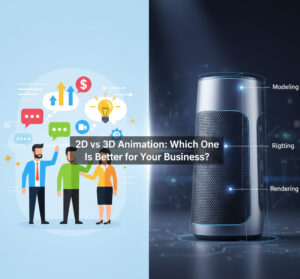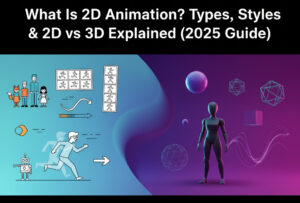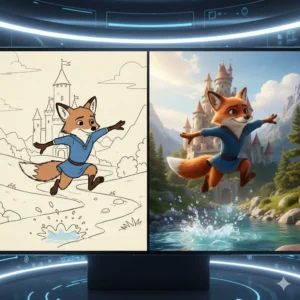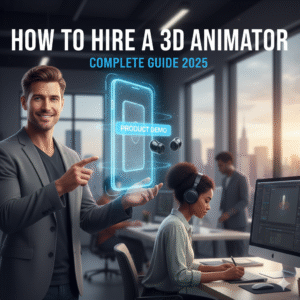In today’s digital-first world, animation has become more than just entertainment it’s a powerful marketing tool that drives conversions, builds brand identity, and simplifies complex ideas. Businesses across industries now face a crucial decision: 2D vs 3D animation which animation style produces better results?
If you’ve ever wondered about the difference between 2d and 3d animation, their costs, effectiveness, or which animation style aligns better with your business goals, you’re in the right place. This comprehensive guide dives deep into every aspect of 2d animation vs 3d animation and gives you a clear roadmap to choose the best animation style for marketing.
Understanding the Core Concepts of Animation
Before comparing styles, let’s clarify what animation actually means in a business context. Animation is the art of creating motion by sequencing images or objects, used to tell stories, explain products, or visually communicate brand messages. When applied to marketing, it fuels visual storytelling, boosts audience retention, and enhances emotional engagement.
At its core, animation relies on techniques such as frame-by-frame animation, storyboarding, and advanced digital processes like CGI animation, rendering, modeling, and rigging. These elements shape how visuals come to life on screen.
What Is 2D Animation? (2D Animation Meaning Explained)
2D animation meaning refers to creating movement in a two-dimensional space. Characters and elements move only up, down, left, or right. This style is mostly flat and relies on illustrations or vector graphics to simulate motion.
In 2D animation, artists create movement through frame-by-frame animation, often drawing or designing each visual separately. It’s a classic approach used in explainer videos, cartoons, educational content, and social media ads.
Common Features of 2D Animation
- Flat character and environment design
- Simplified visuals
- Strong focus on storytelling
- Faster production timeline
- Budget-friendly process
2D animation for explainer videos is especially popular because it converts complicated information into digestible animated narratives without overwhelming viewers.
What Is 3D Animation? (3D Animation Meaning Uncovered)
3D animation meaning involves creating realistic, three-dimensional models that move in a digital environment. These animations simulate real-world depth, textures, lighting, and shadows.
Here, characters and objects are constructed using modeling, enhanced through rigging, and brought to life with professional rendering techniques. The result is highly realistic and immersive content, often seen in product demos, architectural walkthroughs, and blockbuster movies.
Common Features of 3D Animation
- Realistic visuals
- Depth and perspective
- Advanced textures and lighting
- Complex animation complexity
- High production value
3D animation for product demos allows businesses to present products dynamically from every angle, creating a premium visual experience.
2D Animation vs 3D Animation: Key Differences Simplified
When conducting a direct animation style comparison, the differences become crystal clear:
| Factor | 2D Animation | 3D Animation |
|---|---|---|
| Visual Style | Flat, artistic | Realistic, immersive |
| Production Speed | Faster | Longer |
| Cost | Lower | Higher |
| Complexity | Simple to moderate | Advanced |
| Best For | Explainers, storytelling | Demos, simulations |
Understanding the difference between 2d and 3d animation helps businesses align production style with brand strategy.
Which Is Better 2D or 3D Animation for Business?
The question of which is better 2d or 3d animation isn’t about superiority it’s about purpose. Your business animation strategy should determine your animation preference.
Choose 2D Animation If:
- You want simplicity and fast delivery
- Your message is educational or conceptual
- You have limited budget
- You need engaging animated explainer videos
Choose 3D Animation If:
- You want luxury visual presentation
- Your product needs demonstration
- Realism enhances your message
- Branding prioritizes high-end appeal
Ultimately, 2d vs 3d animation for business depends on your campaign goals and audience expectations.
Cost Matters: 2D vs 3D Animation Cost Comparison
One of the most significant decision points for businesses is budget.
Is 2D Animation Cheaper Than 3D?
Yes, absolutely. Many businesses ask: is 2d animation cheaper than 3d? The answer is generally yes.
- 2D animation usually costs 30%-60% less than 3D
- Requires fewer technical resources
- Faster production means reduced labor costs
The 2d vs 3d animation cost comparison clearly shows that 2D is more budget-efficient, especially for startups and small brands.
Production Timeline: Speed vs Precision
When speed matters, 2D animation wins. Producing a standard explainer video with 2D visuals often takes 2-3 weeks, whereas 3D may require 6-10 weeks due to modeling and rigging demands.
If your marketing campaign has a strict deadline, 2D is often the best animation style for marketing.
Visual Impact: 2D vs 3D Quality
When analyzing 2d vs 3d quality, the difference is obvious:
- 2D animation delivers artistic charm and character appeal
- 3D animation delivers realism and cinematic depth
Both styles can emotionally engage viewers if used correctly what matters is creative execution and messaging.
Best Animation Style for Marketing Campaigns
Your marketing success depends heavily on customer perception and attention span.
2D Animation for Marketing
- Strong for social media stories
- Perfect for storytelling
- Encourages emotional connection
3D Animation for Marketing
- Ideal for high-end product launches
- Builds trust through realism
- Strong for tech and manufacturing industries
Your business animation strategy should choose style based on brand personality, audience psychology, and marketing objectives.
2D vs 3D Explainer Video: Which Performs Better?
When it comes to 2d vs 3d explainer video, both formats can simplify messaging, but their effectiveness varies by industry.
- 2D explains abstract ideas quickly
- 3D explains physical products visually
For service-based businesses, 2D often performs better, while product-heavy brands benefit more from 3D animation.
Role of Visual Storytelling in Business Growth
Visual storytelling transforms complex business concepts into relatable narratives. Whether through 2D or 3D, animation strengthens customer engagement videos and enhances brand recall.
Strong storytelling helps:
- Increase conversion rates
- Boost social media shares
- Improve audience retention
Animation Complexity and Output Quality
Animation complexity increases significantly in 3D production due to advanced modeling, realistic motion physics, and lighting control. While complexity adds sophistication, it also raises costs and timeline demands.
2D remains agile while still delivering strong brand impact.
Choosing the Right Style for Your Brand Identity
Your animation choice becomes part of your brand animation identity. Whimsical brands may favor 2D, while luxury brands often prefer 3D realism.
Ask yourself:
- What emotions do I want to trigger?
- Who is my target audience?
- What message am I trying to communicate?
Your answers lead to the right decision.
Future Trends in Business Animation
Emerging trends show hybrid animation styles blending 2D and 3D elements. These combinations offer flexibility, creative innovation, and immersive experiences without excessive cost pressure.
This trend is rapidly transforming customer engagement videos and reshaping brand storytelling.
Practical Use Cases: Real Business Scenarios
When 2D Works Best
- Brand introductions
- Educational content
- Social media ads
- Animated storytelling
When 3D Works Best
- Product visualization
- Real estate walkthroughs
- Technical simulations
- High-impact advertising
Understanding these applications ensures smarter decision-making.
How to Decide the Best Animation Style for Your Campaign
To finalize, consider:
- Target audience preference
- Budget availability
- Marketing campaign duration
- Communication complexity
Making the right choice elevates your overall marketing ROI and audience loyalty.
Conclusion
When evaluating 2d vs 3d animation, it’s not about which style is superior but which one aligns best with your business needs. 2D animation excels in storytelling, affordability, and pace, making it ideal for explainer videos and social campaigns. Meanwhile, 3D animation brings cinematic realism and visual depth, perfect for high-end product demonstrations and immersive branding.
Understanding the difference between 2d and 3d animation helps you build a smarter business animation strategy that enhances brand visibility, strengthens visual storytelling, and drives measurable growth. Whether you choose simplicity or sophistication, selecting the best animation style for marketing ensures your brand stands out in a visually competitive digital landscape.
Your audience remembers what they see so make it count with the right animation style for your business.
FAQs
1. What is the main difference between 2D vs 3D animation?
2D focuses on flat visuals and storytelling, while 3D adds depth, realism, and technical precision using CGI animation techniques.
2. Which is better 2D or 3D animation for business marketing?
2D is ideal for storytelling and branding, while 3D is better for product visualization and technical explanations.
3. Is 2D animation cheaper than 3D?
Yes, 2D generally costs less due to lower technical complexity and faster production time.
4. Which industries benefit most from 3D animation?
Industries like automotive, healthcare, manufacturing, and technology benefit from realistic product visuals using 3D animation.
5. Is 2D animation still relevant today?
Absolutely. 2D continues to dominate explainer videos due to its clarity and emotional engagement.
6. Can I mix 2D and 3D animation?
Yes, a hybrid approach enhances customer engagement and improves brand animation versatility.
7. Which animation style has a faster production timeline?
2D animation typically has a shorter production timeline compared to 3D animation.






